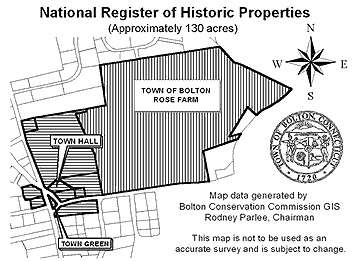by Hans DePold, town historian
(Published in the Bolton Community News, April 2001)
There is a legend about 19th century European colonists who went to Africa and tried to farm the tropical coastline. Poverty and the jungles eventually consumed them. The only thing that was easy for them was finding the minerals that littered their fields and beaches. The natives showed them how these rocks could burn and make a good hot fire, but in the tropics, they had little use. Eventually the survivors left to find opportunities elsewhere. Later it was discovered that the rocks that burned were composed of rough diamonds. The colonists had failed simply because they could not recognize that their fields were littered with rough diamonds that needed only polishing.
In Bolton, our treasures are our land and historic buildings. The recent State Historic Preservation Office (SHPO) nomination of our Town Green for listing in the National Register of Historic Places is recognition that some of Bolton's streets are lined with potential gems. How did this all come about?
It started with a routine SHPO visit in 1999 to look at Dave Loda's historic house on Hebron Road. Dave was told that SHPO had a special program for nominating Connecticut town greens to the National Register of Historic Places, at very little cost to the towns. Normally the research required for nomination costs more than $2,000 per building or site. The Bolton Historical Society asked for an informational meeting February 11, 2000.
In spite of a blizzard that night, every private owner of a colonial house on the green who was in town attended, as did Reverend Charles Ericson of the Bolton Congregational Church, town Administrative Officer Joyce Stille, Town Clerk Susan DePold, Dave Loda, and myself. SHPO historian David Herzan explained that once on the National Register, a brass plaque citing the historical significance of each property could be installed on that property, just like the ones seen in the historic section of Wethersfield. And, as with the Jared Cone house designation, there are no strings attached! The only reason it is called a Federal Historic District is because the buildings are grouped together near the Town Green.
The only new restriction that would result from such a nomination would be that the public hearing period for tearing down the property would increase from 30 days to 90 days. The town, the church, and the private owners would be eligible for restoration grants, but if federal funds were accepted they would be expected to continue to preserve their property. Otherwise, the property owners could do what they wanted with their property and get free restoration advice.

It was unanimous; everyone favored listing in the national register. For what would normally cost at least $16,000 our goal was set to keep the cost to no more than $3,000. There were three action items: first get bids from historians for the work; second, see if town funds would be available at the end of the fiscal year; and third, see if Dave Loda could get a grant from United Technologies Corp.
Just one historian was willing to do the job for $3,000, and Dave Loda was successful in obtaining a United Technologies Corporation grant for $2,000. The historian then agreed to do the work for $2,000, knowing that SHPO already had done a great deal of research on the properties. SHPO wanted the Rose Farm house included and the grant also specified it be included. The Bolton Historical Society accepted the grant from UTC and made Dave Loda the project leader.
The Hartford Courant first reported that the selectmen would oppose the nomination of both the Town Green and the Rose Farm, but in October the town opposed only the inclusion of the Rose farmhouse in the study. None of the other nominees opposed their own nominations, and SHPO ruled to include the farmhouse in the study. Several of the private owners met at the Congregational Church to find out what was going on, and why there was so much commotion. The owners who missed the first meeting in February were present at the second meeting. Some owners were concerned because the nomination seemed too good to be true and it seemed odd that the town was concerned.
In December the nomination study report was completed and everyone was notified that it was available in town hall. Everyone was also notified that the final hearing of the Connecticut Historical Commission was February 15, 2001. Again, the only opposition to the nomination was from the town selectmen. The nomination was approved and SHPO submitted it for the National Register of Historic Places. As town historian appointed by the selectmen, I felt obligated not to oppose the selectmen at the hearings, nor have any involvement with SHPO's decision, although I was pleased with it. Dave Loda worked hard to see the project through from start to a successful completion.
From my point of view the nomination was a great honor. It was as though the experts told us we had diamonds in the rough if we were willing to open our eyes and recognize them. Now, will we find a way to polish them for the benefit of our town? Bolton has been proud to have the Jared Cone house on the National Register. With this SHPO nomination we will soon add four more private residences, our Town Green, our Town Hall, our Bolton Congregational Church buildings, our Rose farm buildings, and a total of 130 acres to the National Register. This is all on the Washington-Rochambeau Revolutionary Route National Historic Trail that we hope will go through Bolton Center by 2006.